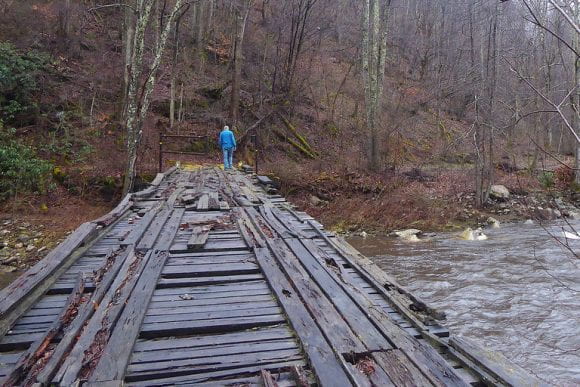IMAGE OF THE WEEK

Mike Hermann visits near Parsons, West Virginia, while working on the Elkins-Otter Creek Lizard Map of the Monongahela National Forest. See alumni profile story on how this cartographer founded an adventure map company. Image: Purple Lizard
GOOD NEWS
Harman Singh received an Erickson Discovery Grant for summer 2020, for her project, “Examining the Relationship between Flooding and Land Use Land Cover in Kochi through a Mixed Method Approach.”
Emily Sikora used her final project for GEOG 320 Urban Geography: A Global Perspective with Emily Rosenman during spring semester to highlight the problem of homelessness in New York City and the increased vulnerability of this population to Covid-19.
Andrea Garcia wrote the articles “From 1967 to 2020: A history of the racism Black students have faced at Penn State” and “Black community members at Penn State share frustrations with university’s administration” in The Daily Collegian.
Emily Rosenman received a seed grant for “‘Invest in People, Literally’: The Rise of Income Share Agreements as an Alternative to Student Loans in US Higher Education,” from the Penn State and the University of Auckland Joint Collaboration Development Program.
Esri will host a brownbag chat on Tuesday, July 7, at 9:00 a.m. (PDT) on Teaching with and Using ArcGIS Experience Builder to Create Customized Web Mapping Applications.
NEWS
Purple Lizard geographer’s mission to aid outdoor discovery
It took a global pandemic to convince many of something Mike Hermann has long known: We are surrounded by some amazing outdoor attractions.
Hermann, founder of the adventure map company Purple Lizard and a 1995 Penn State geography alumnus, said he founded the company after attending the University and realizing how little people knew about the area that surrounds them. Since 1997, he’s parlayed his love of geography and outdoor landscapes into his business venture.
World Campus graduate, reservist wins award for geospatial intelligence
When Lauren Maloney trained in military intelligence with the U.S. Air Force, she was impressed by how much information could be conveyed by geospatial intelligence, which uses images and data to analyze activity in specific locations.
Climate change is also a racial justice problem
Gregory Jenkins is interviewed
If humanity is going to effectively tackle climate change, scientists and activists told me, it’s a question we have to answer. You can’t build a just and equitable society on a planet that’s been destabilized by human activities, they argue. Nor can you stop the world from warming without the experience and the expertise of those most affected by it.
Summer Series on questions of geo-ethics and Human Rights highlighted by COVID-19 Conditions
This series developed from discussions that took place at the AAG’s Virtual Annual Meeting, April 6-10, 2020, during publicly available panels of the breaking theme “Geographers Respond to COVID-19”. The panels were set up by AAG specialty groups and their chairs who wanted to initiate discussions about the ongoing pandemic using a geographic lens, showcase the application of geography to urgent issues, and to learn from the evolving circumstances to build future preparedness. Recordings of the panels are still available for anyone to watch.
RECENTLY PUBLISHED
Conceptual Links between Landscape Diversity and Diet Diversity: A Roadmap for Transdisciplinary Research
Sarah E Gergel, Bronwen Powell, Frédéric Baudron, Sylvia L R Wood, Jeanine M Rhemtulla, Gina Kennedy, Laura V Rasmussen, Amy Ickowitz, Matthew E Fagan, Erica A H Smithwick, Jessica Ranieri, Stephen A Wood, Jeroen C J Groot, Terry C H Sunderland
BioScience
https://doi.org/10.1093/biosci/biaa048
Malnutrition linked to poor quality diets affects at least 2 billion people. Forests, as well as agricultural systems linked to trees, are key sources of dietary diversity in rural settings. In the present article, we develop conceptual links between diet diversity and forested landscape mosaics within the rural tropics. First, we summarize the state of knowledge regarding diets obtained from forests, trees, and agroforests. We then hypothesize how disturbed secondary forests, edge habitats, forest access, and landscape diversity can function in bolstering dietary diversity. Taken together, these ideas help us build a framework illuminating four pathways (direct, agroecological, energy, and market pathways) connecting forested landscapes to diet diversity. Finally, we offer recommendations to fill remaining knowledge gaps related to diet and forest cover monitoring. We argue that better evaluation of the role of land cover complexity will help avoid overly simplistic views of food security and, instead, uncover nutritional synergies with forest conservation and restoration.
Hunter and Non-Hunter Perceptions of Costs, Benefits, and Likelihood of Outcomes of Prescribed Fire in the Mid-Atlantic Region
Zachary D. Miller, Hong Wu, Katherine Zipp, Cody L. Dems, Erica Smithwick, Margot Kaye, Peter Newman, Anthony Zhao & Alan Taylor
Society & Natural Resources
DOI: 10.1080/08941920.2020.1780359
In the mid-Atlantic region, prescribed fire is as an important tool for natural resource managers to achieve a variety of outcomes, including the management of wildlife habitat and wildfire risk reduction. However, little research has been conducted in this region to help inform managers about public perceptions and acceptance of prescribed fire. In this research, data from intercept surveys of hunter and non-hunters on public lands in New Jersey and Pennsylvania are used to compare perceptions of perceived costs, benefits, and likelihood of outcomes for these groups related to prescribed fire. Results show that hunters generally had lower levels of perceived costs and likelihood of negative outcomes from prescribed fire than non-hunters. From this, managers using prescribed fire in these areas can better understand public perceptions, differences among recreation users, and possibly better communicate about using prescribed fire as a tool for managing resources.
